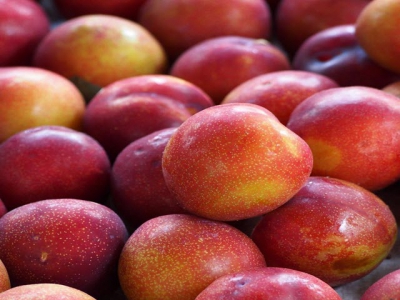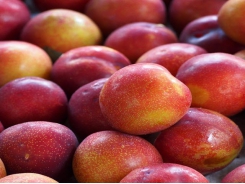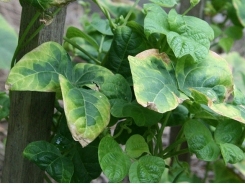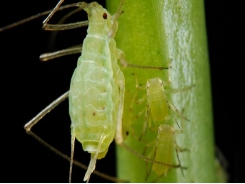Pests and Diseases of Tree Fruit - Part 2

Peach leaf curl (Taphrina deformans)
This affects peaches, almonds and nectarines.
Typical symptoms: Red blisters appear on leaves in early summer; infected leaves turn brown and fall prematurely. Regular attacks will reduce the vigour of the tree.
Prevention and treatment: Do not plant susceptible trees in cool, damp situations, especially near a pond. Small trees and those grown against a wall can be covered with a structure to keep the rain off. This will prevent the transfer of disease spots from the bare wood to the developing leaves and it should be kept in place from early spring until all the leaves have developed. Where practical, remove and burn or dispose of affected leaves as soon as they are noticed. Spray with Bordeaux mixture as directed on the container, usually in mid- to late winter, just before leaf fall. If regular spraying is required, consider growing species of top fruit other than peaches, almonds and nectarine and instead concentrate on those not prone to this disease.
Pear and cherry slugworm (Caliroa cerasi)
This affects pear and cherry along with almond, hawthorn, rowan and related trees and shrubs.
Typical symptoms: The upper surface of the leaves is grazed so that only the skeleton remains. Small, shiny black, slug-like larvae may be seen.
Prevention and treatment: Where pests are seen, remove them by hand. If this is not practical, spray with derris or insecticidal soap. In winter, lightly cultivate the soil under infested trees. This will expose overwintering pupae to predators. Remove mulches and replace with new material in the spring.
Pear midge (Contarinia pyrivora)
This pest attacks pear trees only.
Typical symptoms: Small fruitlets become swollen and distorted and they blacken. Such fruit fails to develop normally; when it is cut open, small larvae may be found inside.
Prevention and treatment: Grow early- or late-flowering pear varieties which should not be flowering when the midge is laying its eggs. Pick off all affected fruitlets and collect up all fallen fruit as soon as it is noticed. Destroy immediately. Lightly cultivate the soil around the trees in summer or autumn to expose midge cocoons. Remove and compost mulches in autumn; replace with fresh material in the spring.
Plum fruit moth (Cydia funebrana)
Plum and damson are susceptible to this insect.
Typical symptoms: Small white or pink caterpillars eat into the fruit in mid- to late summer. The fruit rots and/or ripens early.
Prevention and treatment: Collect up and destroy affected fruits as soon as the presence of this pest is noticed, before the caterpillars leave them.
Plum rust (Tranzschelia prunispinosae)
This affects plums, apricots, peaches, almonds and nectarines (also Anemone species).
Typical symptoms: Bright yellow spots appear on the leaves from mid-summer. The leaves turn yellow and may fall early.
Prevention and treatment: Pick up and remove all fallen leaves in the autumn. If they are made into leafmould, do not use this on susceptible trees. Remove anemones in the vicinity if the problem is severe.
Plum sawfly (Hoplocampa flava)
Plum sawfly affects plums and damsons.
Typical symptoms: Creamy-white sawfly larvae eat into developing fruit. Holes in the damaged fruit exude a sticky “frass”. The fruit may fall prematurely, severely reducing the crop. The level of attack may vary considerably from year to year.
Prevention and treatment: Remove and compost all fruit that falls early. Where this pest is known to be a problem, spray with derris as directed on the container, usually when the petals fall.
Poor fruiting
This affects all tree fruit.
Typical symptoms: Various factors can be responsible for poor fruiting, frost being an important cause.
Prevention and treatment: See Plant Disorders – Understanding the Problem
Red spider mite, fruit tree (Panonychus ulmbi)
Apples, pears, plums and damsons are susceptible to this pest.
Typical symptoms: Leaves are speckled, bronzed and dried up; they may fall prematurely. With the aid of a magnifying lens, tiny mites may be seen under the leaves.
Prevention and treatment: Encourage the activities of typh lodrom id mites and anthocorid bugs, the natural enemies of this pest. Where mites are present in small numbers, remove all infested leaves. If the infestation is severe, spray with derris or insecticidal soap—though this can be counter-productive as the sprays can harm natural predators.
Silver leaf (Chondrostereum purpureum)
This affects plums, damsons, cherries, apples, apricots (also hawthorn and other rosaceous trees and shrubs).
Typical symptoms: Silvery sheen appears on the leaves; symptoms may be confined to a single branch initially. Infected wood shows a dark brown discoloration within when cut through and may die back in late summer.
Prevention and treatment: Do not prune susceptible trees between early autumn and late spring; the disease will gain entry through pruning cuts more easily when the tree is not actively growing. Natural recovery is quite common. If the disease persists, cut out and burn or dispose of infected wood. Treat pruning cuts with Trichoderma paste. B I nab Trichoderma pellets can be used to treat infected trees and to protect those at risk.
Wasps, common (Paravespula vulgaris)
Apples, pears, damsons and plums are attacked.
Typical symptoms: Large holes are found in ripening fruit in summer and early autumn.
Prevention and treatment: Tolerate damage if possible; at other times of the year, wasps are useful predators of caterpillars and other pests. Wasps very often extend damage to fruit caused by diseases, disorders or pests such as birds. Dealing with these problems may reduce wasp damage. If essential, trap wasps in jars containing a little jam, some water and detergent.
Winter moths (Operophthera brumata, Alsophila aescularia, Erranis defoliaria)
Apples, pears, plums and damsons are susceptible to winter moths.
Typical symptoms: Young leaves, flowers and buds are eaten by “looper” caterpillars. These tend to drop to the ground when disturbed.
Prevention and treatment: Apply tree grease or grease bands to trees and stakes from mid-autumn to late spring (see Garden Pests and Diseases – Barriers and Traps). These will prevent the female moths from making their way up into the tree. In spring, check trees regular- ly and remove any caterpillars found. If the problem is severe, spray with derris at bud burst.
Woolly aphid (Eriosoma lanigerum)
This affects apple, crab apple and other related ornamental plants.
Typical symptoms: Conspicuous tufts of white “cotton wool” appear on stems and branches of trees. This “wool” is protecting colonies of aphids. Infested stems and branches may develop hard, irregular, woody swellings which can split open, allowing diseases such as canker to infect the tree.
Prevention and treatment: See Aphids as Garden Pests
Related news
Tools

Phối trộn thức ăn chăn nuôi

Pha dung dịch thủy canh

Định mức cho tôm ăn

Phối trộn phân bón NPK

Xác định tỷ lệ tôm sống

Chuyển đổi đơn vị phân bón

Xác định công suất sục khí

Chuyển đổi đơn vị tôm

Tính diện tích nhà kính

Tính thể tích ao




 Planting Preparations for Growing Tomatoes
Planting Preparations for Growing Tomatoes  Biological Control of Common Greenhouse Pests - Part…
Biological Control of Common Greenhouse Pests - Part…